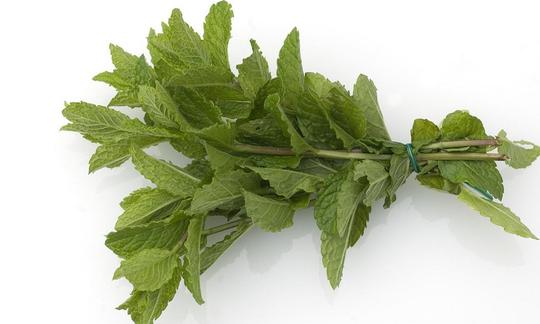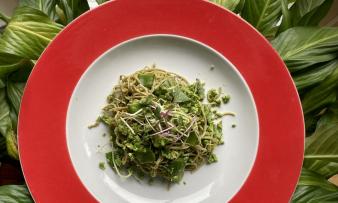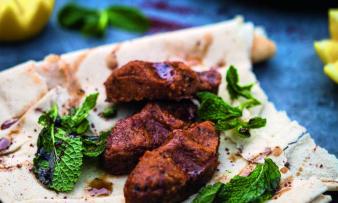Table of contents
Moroccan mint ( Mentha spicata, var. crispa 'Morocco') is a variety of spearmint cultivated in North Africa. It is traditionally used raw as a tea infusion or to season and garnish dishes (preferably in organic quality).
Use in the kitchen
Moroccan mint (raw) has a slightly peppery taste and a minty, fresh, sweet scent. As a variety of green mint, it also contains very little menthol and is therefore somewhat milder in taste than the fresh peppermint that is better known in Europe. Green mint and its descendants have been indispensable in culinary culture since Roman times. 1 Fresh Moroccan mint is particularly important in Maghreb tea culture and as the main ingredient in the Moroccan national drink "thé à la menthe". In traditional North African cuisine, it is also used as a seasoning ingredient or garnish for kebabs, pies, salads, sauces, soups and heartier dishes.
Its refreshing taste is used in bulgur meatballs (vegan Moroccan meatballs) with lemon and mint, as a topping for an oriental chickpea and lentil soup, or as a refreshing ingredient in various salads, such as an orange salad, couscous salad, or a shawarma salad with millet, pistachios, and mint. But raw Moroccan mint also goes perfectly with a vegan vegetable tagine with tomatoes, onions, yellow bell peppers, and aubergines. Most North African and Arabic dishes are enriched with cumin, nutmeg, cinnamon, and saffron, which combine well with the mint.
In desserts, Moroccan mint can be served with fruits such as watermelon, strawberries, limes,blueberries, blackberries, grapefruit or pomegranates.
In addition to the famous mint tea, which is traditionally served as a dessert in Morocco, Moroccan mint also refreshes cold drinks, such as various iced tea variations or non-alcoholic cocktails, such as the "Hugo".
Vegan recipe for carrot salad with Moroccan mint
Ingredients (for 4 people): 600 g carrots (organic), 50 g green olives cut into rings, ½ tsp coriander seeds (ground), 1 ½ tsp cumin powder, 1 clove of garlic (finely chopped), 1 tsp harissa (more or less to taste), 2 tbsp rapeseed oil, 3 tbsp red wine vinegar, ¾ tsp orange zest, 2 stalks fresh Moroccan mint (leaves finely chopped), 1 tbsp parsley (finely chopped).
Preparation: Wash the carrots well and cut them into smaller pieces with the skin on. Cook for about ten to twelve minutes, drain and rinse in cold water. Mix the red wine vinegar, rapeseed oil, garlic, harissa, fresh Moroccan mint and orange zest with the spices and then mix with the carrots. Fold in the olives and season with salt and pepper. Pour the salad into a bowl and sprinkle with parsley.
Tea preparation for traditional Moroccan mint tea
Ingredients for 1 liter: 3 teaspoons green tea (preferably gunpowder), 4 sprigs of fresh Moroccan mint (organic), 1 tablespoon sugar (more or less according to taste), 1 liter water.
Preparation: Put the green tea in a pot, pour hot, but no longer boiling, water over it and let it steep for two minutes. Pour the first infusion through a sieve to counteract the bitter taste. Then add the mint and sugar and let it steep for another three to four minutes. In Morocco, a whopping 100 g of sugar is used for half a litre of tea. Here, however, we recommend much less. If you have guests, we recommend putting individual, previously washed, fresh mint leaves into the glasses to make the whole thing more visually appealing.
Vegan recipes with Moroccan mint can be found under the note: " Recipes that have the most of this ingredient ".
| Not only vegans or vegetarians should read this: Vegans often eat unhealthily. Avoidable nutritional errors. |
Purchasing - Storage
Fresh mint (cut) is available all year round from major retailers such as Coop, Migros, Denner, Volg, Spar, Aldi, Lidl, Rewe, Edeka, Hofer, Billa, and is also available in organic quality in organic supermarkets such as Denn's Biomarkt and Alnatura. In stores, it is often also sold as nana mint 3, although this also includes nana peppermint ( Mentha x piperita var. piperita 'Nana') and the actual nana mint ( Mentha spicata var. crispa 'Nane'), also known as Turkish mint. You have a real chance of buying raw Moroccan mint in Turkish or Arabic food markets.
The availability of Moroccan mint varies depending on the size of the store, catchment area, etc. If you are interested, click on our recorded food prices for the DA-CH countries (above under the ingredient image). There you will find current prices from various supermarkets and their price development.
Storage tips
Fresh Moroccan mint can be stored in a sealable plastic bag in the refrigerator, but only for a short time. It will last a little longer if you put the stems in a glass of water. If you freeze the leaves, they will last even longer and retain their aroma better than if they were dried. In dried form, it is recommended that you store them in a cool, dry place.
Ingredients - Nutritional values - Calories
The nutrients in Moroccan mint (raw) are the same as those in green mint. 100 g have a calorie content of 44 kcal. There is hardly any fat, carbohydrates make up about 8.4 g and protein 3.3 g. The fiber content is 6.8 g/100g. 2
Moroccan mint is rich in iron with 12 mg/100g; that is 85% of the daily requirement. Fresh marjoram and morels contain a similar amount. Dried spices contain significantly more iron, but you consume much less: for example, dried oregano has 37 mg/100g iron. 2
100 g of Moroccan mint contains 1.1 mg of manganese (56% of the daily requirement). Fresh basil has the same amount and fresh dill (1.3 mg/100g) has a similar amount. Sage contains almost four times as much manganese at 4 mg/100g. 2
The folate (folic acid) content in raw Moroccan mint is 105 µg/100g (53% of the daily requirement). This is similar to fresh rosemary (109 µg/100g) and fresh peppermint (114 µg/100g). Significantly more folate can be found in raw Mexican goosefoot or in dried herbs ( e.g. thyme 274 µg/100g). 2
The complete ingredients of Moroccan Mint, the coverage of the daily requirement and comparison values with other ingredients can be found in our nutrient tables. In the article Nutrients explained you will get a detailed insight into the topic.
Effects on health
Is Moroccan mint healthy? Although Mentha spicata var. crispa 'Morocco' has rarely been the focus of research into its effects on human health, it is also rich in known essential oils and secondary plant substances (flavonoids). An essential oil can be extracted from all types of mint. This oil contains various terpenes and, depending on the origin, environment and climate, has either limonene, carvone, pulegone or menthone as the main component. 3 The main terpene found in Moroccan mint is in most cases carvone. 4 This has bacterial growth-inhibiting properties and acts as both a fungicide and an insect repellent. 5 Moroccan mint is considered a natural variety of spearmint ( Mentha spicata) and has been shown to have antifungal, antimicrobial, anti-inflammatory, antitumor and antioxidant activities due to the flavonoids it contains. 6
Due to its relationship to spearmint, similar effects of the Moroccan variety are assumed, but have not yet been scientifically proven.
Dangers - Intolerances - Side effects
As with green mint, only a small amount of menthol can be distilled from Moroccan mint. Nevertheless, essential oils should be used with caution. Larger amounts (including menthol) can have a harmful effect on the central nervous system, kidneys and respiratory tract of small children, which is why mint oil is not recommended for children under 4 years of age. 7
Use as a recognized medicinal plant
Commission E has recognized mint oil for the following medical applications: internally for bloating, stomach, intestinal and gallbladder complaints and catarrh. Externally for muscle pain, nerve pain and as a nasal ointment. 7
Ecological footprint - animal welfare
The ecological CO 2 footprint of a food depends on various factors. The type of agricultural production (conventional vs. organic), average or seasonal or regional production, domestic production or import by truck, ship or plane, different types of packaging and whether the goods are fresh or frozen play a decisive role. 8 Despite extensive research, however, we were unable to find any precise figures on the ecological CO 2 footprint of Moroccan mint.
Organically grown Moroccan mint is preferable to conventionally grown mint because organic farming avoids the use of synthetic fertilizers and pesticides. Interestingly, the essential oils of the mint itself have shown promising effects as a bioherbicide. In a 2019 study, the use of mint oils stopped the growth and ultimately killed weeds. 13 Since the synthetic herbicides and pesticides used in conventional agriculture have a negative impact on the environment, this could offer a promising alternative.
If you use mint to make tea, make sure you only boil the amount of water you really need. One tea manufacturer reported that 36% of its total carbon footprint created in 2021 was due to boiling the tea water, as consumers sometimes boiled twice as much water as necessary. 14
Animal protection - species protection
Moroccan mint is also important for the animal world. Bees, bumblebees and hoverflies benefit from its flowers.
Worldwide occurrence - cultivation
As the name suggests, the Moroccan tea comes from Morocco. There it is grown primarily for local but also international tea consumption and for the production of essential oils. 3,4,9
Cultivation - Harvest
Moroccan mint is a perennial plant and requires a partially shaded to sunny location with moist, humus-rich soil. 11 It can be easily grown in your own garden or in a pot on the balcony.
To ensure that it grows healthily in your own garden, you should water it regularly to keep the soil slightly moist. If necessary, use organic fertilizer and cut the plant back a little before it flowers. Nettles have proven to be good neighbor plants and can improve the aroma and serve as fertilizer. 10
Since all mints have an invasive character, you should use a rhizome barrier when planting in the garden. This prevents the root runners from spreading throughout the garden. 12
Further information
Moroccan mint ( Mentha spicata, var. crispa 'Morocco') belongs to the mint family and is a natural variety of spearmint ( Mentha spicata).
Alternative names
In the Persian-Arabic language area, Moroccan mint, like all other types of mint, is called "nana", which means "mint". In addition to the commercially common name "nanamint", it is also often called Arabic mint or Morocco mint. In English it is known as nanamint or Moroccan mint. Incorrect spellings, such as Moroccan mint or Moroccan mint, can creep in.
Other uses
When hung in bunches, Moroccan mint is also an effective insect repellent. The menthol contained in the mint is also processed into a popular sauna crystal.
Bibliography - 14 Sources
| 1. | Bown, D. RHS Encyclopedia of Herbs & Their Uses. 1. Auflage. London: Dorling Kindersley Ltd.; 1995. |
| 2. | USDA United States Department of Agriculture. |
| 3. | Reiner, H. Vielseitig nutzbar: Minzen. Garten. 1996;119(3):24-26. |
| 4. | El Anbri, C. Essential oil chemical diversity of Moroccan mint (Mentha spicata L.). Moroccan Journal of Agricultural Sciences. 2022. |
| 5. | Ay Kee L, Bakr Shori A, Salihin Baba A. Bioactivity and health effects of Mentha spicata. Integr Food Nutr Metab. 2017;5(1):1-2. |
| 6. | Ounoki R, Ágh F, Hembrom R, Ünnep R, Szögi-Tatár B, Böszörményi A, u. a. Salt stress affects plastid ultrastructure and photosynthetic activity but not the essential oil composition in spearmint (Mentha spicata L. var. crispa “Moroccan”). Front Plant Sci. 29. 2021;12:739467. |
| 7. | Arnzeipflanzenlexikon Minze. |
| 8. | Reinhardt G, Gärtner S, Wagner T. Ökologische Fussabdrücke von Lebensmitteln und Gerichten in Deutschland. Institut für Energie- und Umweltforschung Heidelberg ifeu. 2020;1-22. |
| 9. | Gartenjournal net Woher stammt eigentlich Minze? Die Antwort mag überraschen. |
| 10. | Gartenjournal net Marokkanische Minze: So gedeiht sie optimal in Ihrem Garten. |
| 11. | Wildfind com Marokkanische Minze. |
| 12. | Gartenjournal de Minze züchten leicht gemacht: Schritt für Schritt Anleitung. |
| 13. | Sarheed MM. Allelopathic compounds from Mint target the cytoskeleton from cell biology towards application as bioherbicides. 2019. |
| 14. | PUKKA. Impact Report 2021. Aufgerufen am 05.09.2023 auf https://drive.google.com/file/d/1ErPgoZ1Qnc0ERn9Mkl4Nrw3I6IY3laoP/view?pli=1 |











Comments